Key takeaways:
- Culinary education blends creativity with science, enhancing both traditional techniques and innovative practices.
- Fermentation transforms flavors and textures, adds nutritional benefits, and fosters cultural connections through shared culinary practices.
- Patience and experimentation are crucial to successful fermentation, allowing for personal creativity and community engagement.
- Practical tips for home fermentation include ensuring sanitation, starting small, and keeping a detailed fermentation journal for tracking progress.

Introduction to culinary education
Culinary education opens up a world of creativity and skill, allowing aspiring chefs to turn their passion into a profession. I remember my first day in culinary school, surrounded by the intoxicating aromas of fresh herbs and spices—I could feel the excitement in the air. Has there ever been a moment in your culinary journey where you felt that spark of inspiration?
In the classroom, we don’t just learn recipes; we dive deep into the science behind cooking. For instance, understanding how heat affects proteins transformed my approach to cooking meats. Isn’t it fascinating how a little knowledge can elevate a dish from ordinary to extraordinary?
Moreover, culinary education emphasizes the importance of tradition and innovation. I often reflect on my experiences with traditional cooking techniques that my grandmother used—there’s something magical about those time-honored methods that connects us to our roots. How do you think exploring such traditions could enhance modern culinary practices?
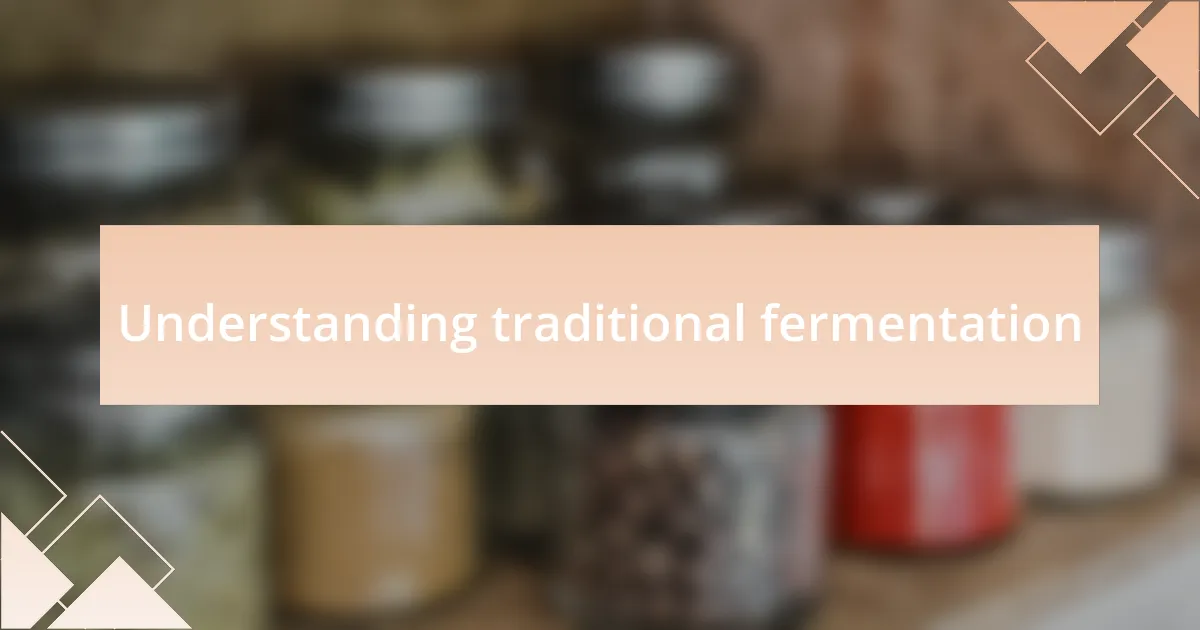
Understanding traditional fermentation
Traditional fermentation is a culinary practice steeped in history and culture. I still remember the first time I observed my neighbor preparing kimchi; the vibrant ingredients and the meticulous process captivated me. It made me realize that fermentation is not just about preserving food—it’s an art form that transforms flavors and textures over time.
Through my experiences, I learned that fermentation relies on microorganisms like bacteria and yeast, which break down sugars and produce acids and gases. The science behind it can sometimes seem daunting, but the beauty lies in its simplicity. Have you ever made yogurt at home? That moment when you see the creamy texture form is a delightful assurance that nature is working its magic.
What struck me most was how different cultures have their own fermentation traditions, creating unique flavors and health benefits. For example, when I first tasted miso soup made with freshly fermented miso, it was nothing short of enlightening. It’s remarkable to think how these age-old methods of food preparation not only nourish us but also preserve history and foster community.
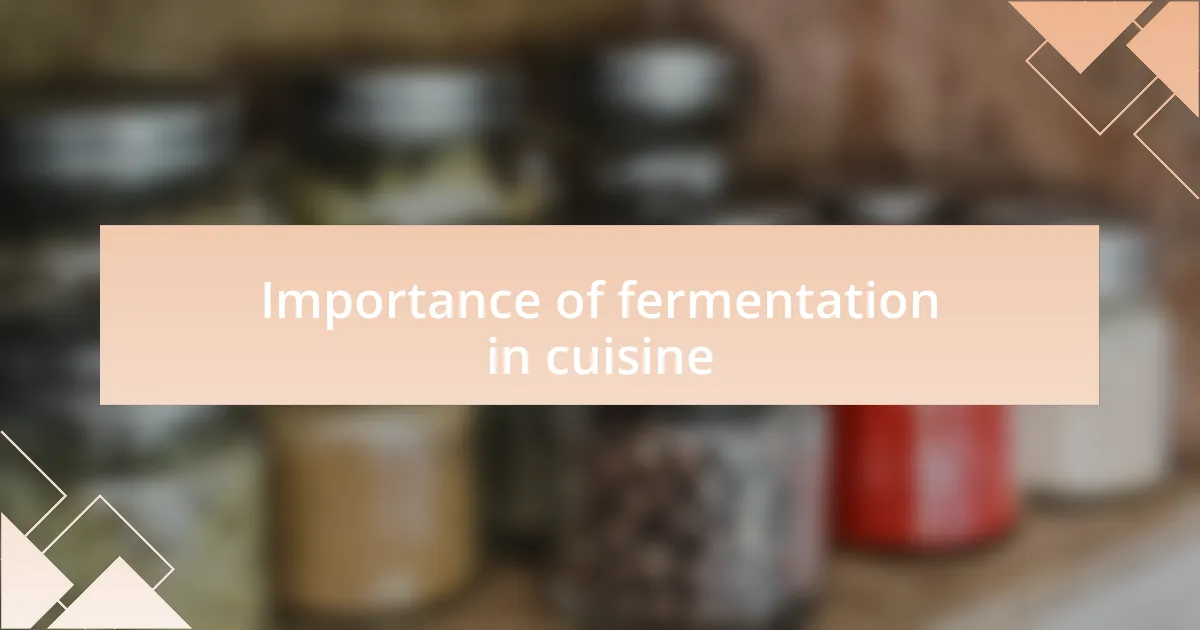
Importance of fermentation in cuisine
Fermentation plays a pivotal role in cuisine, unlocking complex flavors that cooking alone simply can’t achieve. I vividly recall the first time I enjoyed naturally fermented sourdough bread; the tangy profile and chewy crust were a revelation. Have you ever bitten into something that made you stop and appreciate the transformation it underwent? That’s the magic of fermentation.
Beyond flavor, fermentation also enhances the nutritional value of foods. For instance, when I have sauerkraut, I’m not just savoring the taste; I’m reaping the benefits of probiotics, which are great for gut health. It’s fascinating to think that a simple jar of cabbage can provide such a boost to our well-being—who knew that something so humble could be such a powerhouse?
Moreover, fermentation fosters a connection to our culinary heritage, as every culture has its unique approach to this ancient practice. I often find myself drawn to the stories behind traditional dishes like kimchi or tempeh; they are more than just food; they are a testament to the ingenuity of our ancestors. When we embrace fermentation, we’re not just savoring flavors; we’re partaking in a time-honored dialogue of tradition and innovation.
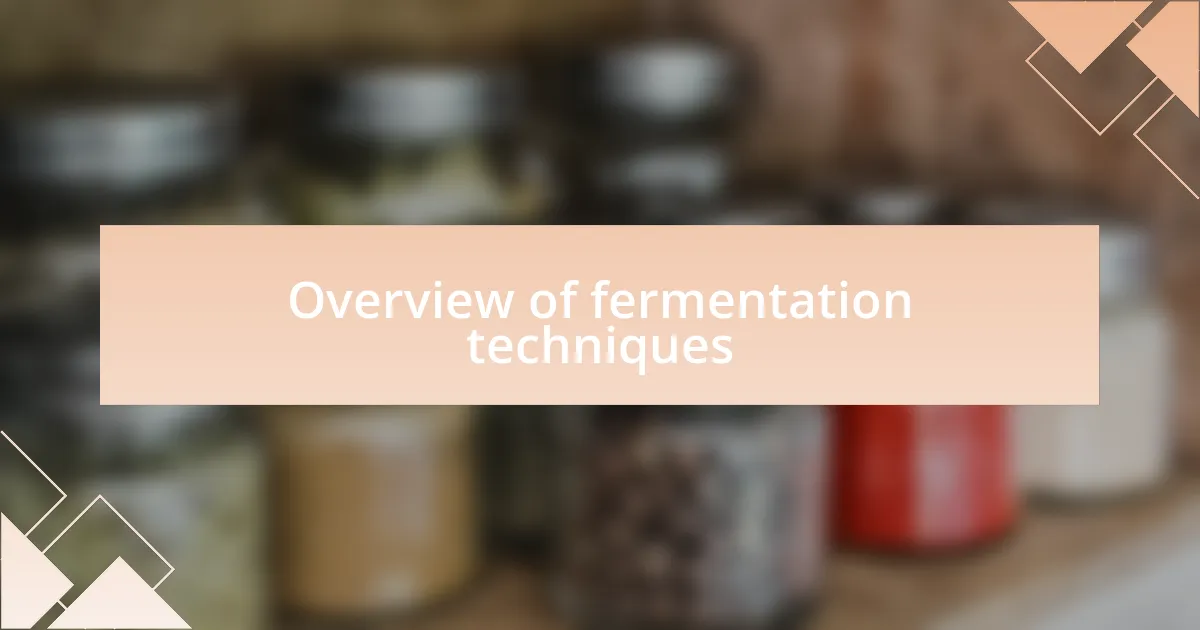
Overview of fermentation techniques
Fermentation techniques vary widely across different cultures, and I find it absolutely fascinating how a few simple ingredients can yield such diverse results. Take, for example, the art of beer brewing, where yeast transforms sugars into alcohol, creating a symphony of flavors. The first time I attempted brewing at home, I was mesmerized by the process—watching bubbles rise in the fermenter felt like witnessing magic in action. Have you ever thought about how a seemingly mundane process can lead to something that brings people together?
In contrast, I often think about methods like pickling, where vegetables are submerged in a brine solution to enhance their crunch and flavor. The first time I bit into a homemade pickle experiment, I was surprised by the way the tanginess danced on my tongue. It made me appreciate the transformation—a reminder that patience is key, as great flavors often take time to develop. Can you remember the last time you tried something that was worth the wait?
Then there’s the world of dairy fermentation, where milk is turned into yogurt or cheese through a controlled process involving specific bacteria. I recall making yogurt from scratch; it was exhilarating to see how a simple mixture could turn creamy and tangy overnight. This not only taught me about the science of fermentation but also connected me with the heart of homemade goodness. Each technique brings its own story, and I think that’s what makes fermentation so captivating—each jar or batch reflects a journey.
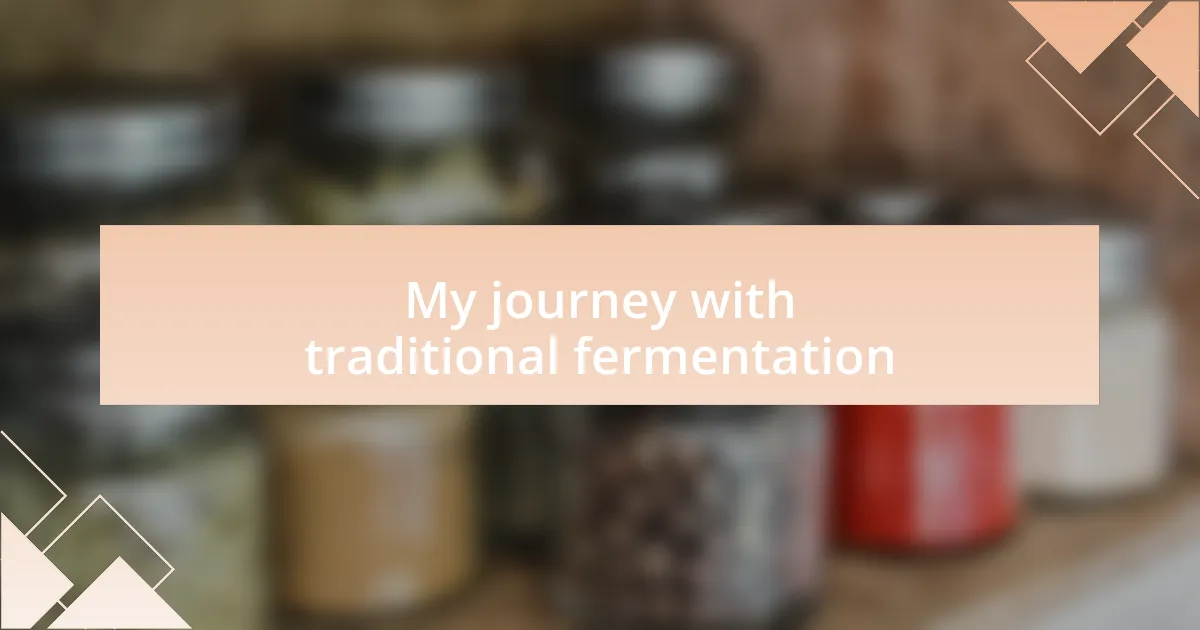
My journey with traditional fermentation
Embarking on my journey with traditional fermentation felt like stepping into a world where flavors and cultures intertwined. I vividly remember my first attempt at making sauerkraut. The smell of fresh cabbage and salt brought back memories of my grandmother’s kitchen, where she poured her heart into every jar. As I pressed down the cabbage, I could feel the anticipation building—would it taste like hers? When the sauerkraut finally fermented, the tangy crunch transported me back in time, reinforcing my belief that cooking is a way to connect generations.
I’ve also dabbled in miso-making, which initially felt daunting. The process involves fermenting soybeans with koji mold, and I was unsure if I could achieve anything close to the shop-bought versions. But as I patiently waited, I found myself reflecting on the miracle of transformation. Each day, I checked on my batch, my excitement growing alongside the aroma developing in the jar. Selecting the right amount of salt and fermentation time felt like a delicate dance, and when it all came together, I was thrilled. Have you ever experienced a moment when your labor of love finally rewarded you?
An unexpected twist in my fermentation journey came through kimchi. I was introduced to this zesty delight at a friend’s house and instantly knew I had to try making it myself. The layering of spices, the crunch of vegetables, and that vibrant color made me feel alive. As I experimented with different ingredients—like adding a hint of mango for sweetness—I realized that fermentation isn’t just about preservation; it’s about creativity and exploration. Have you ever found freedom in your kitchen? For me, every fermentation project has been a reminder to embrace the process rather than focus solely on the end result.
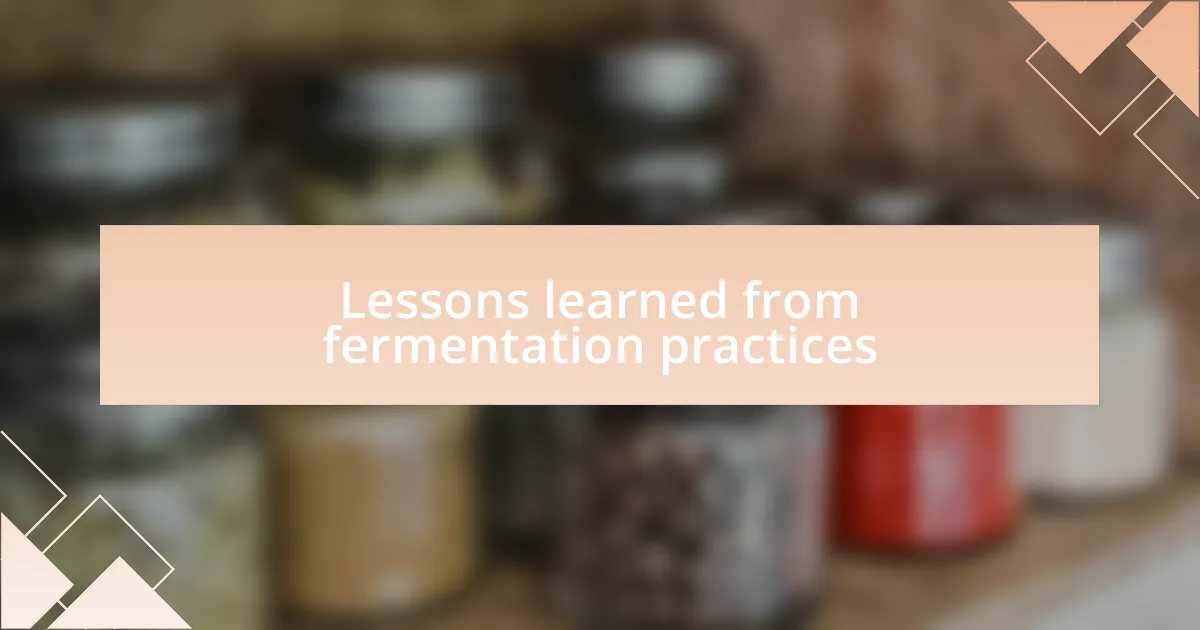
Lessons learned from fermentation practices
One significant lesson I’ve gained from traditional fermentation practices is the importance of patience. I remember one time when I attempted to ferment a batch of pickles. I eagerly opened the jar early, hoping for that crisp, tangy crunch. Instead, I was met with a disappointing, overly salty mess. I learned that fermentation is a slow dance, and each step must be respected. Have you ever rushed a process only to realize that great things take time?
Another insight revolves around the value of experimentation. Early on, I strictly followed recipes, fearing deviation would lead to failure. However, during one creative weekend, I decided to infuse ginger into my kimchi. It was a small change, but the explosion of flavors took me by surprise! This shift in perspective taught me that fermentation is an art form, inviting innovation. Have you allowed yourself to play in the kitchen and discover new favorites?
Finally, I’ve come to understand that fermentation fosters community. I recall hosting a small gathering where everyone shared their fermenting stories and batches. From homemade yogurt to tangy pickles, it became a celebration of shared knowledge and experiences. Engaging in fermentation practices has built connections not just with food, but also with people. Have you ever noticed how food brings us together in unexpected ways? For me, these moments emphasize the communal nature of cooking and learning.
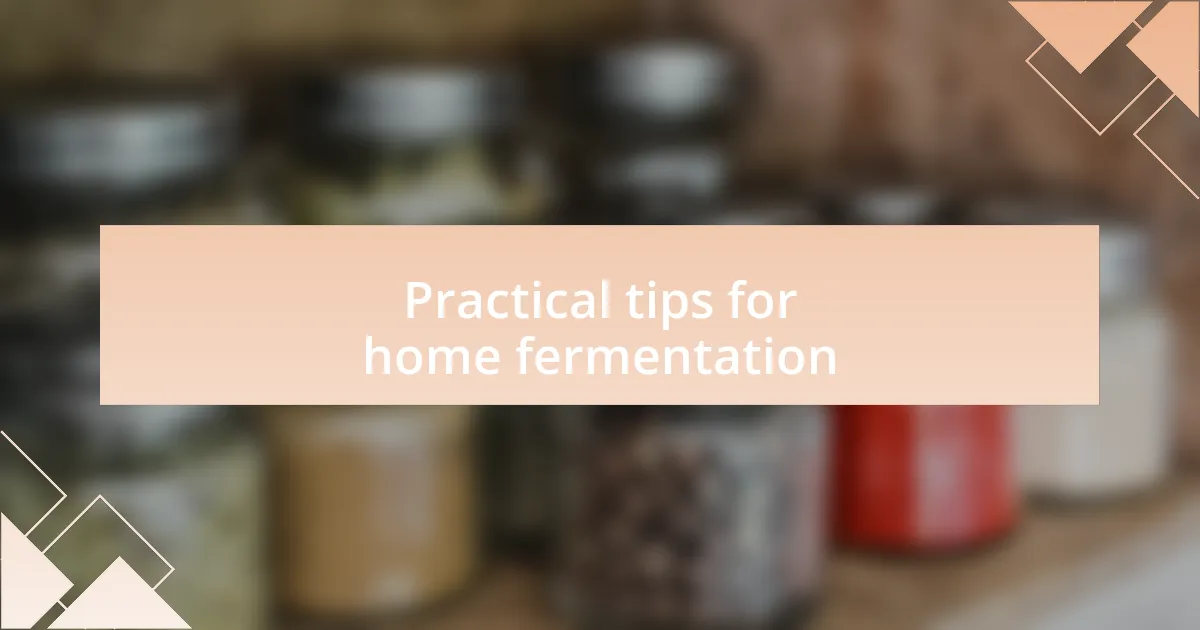
Practical tips for home fermentation
When diving into home fermentation, always ensure that your equipment is impeccably clean. I recall my first attempt at making sauerkraut when I skipped this step. The result? A batch that tasted more like a science experiment than a culinary delight. Remember, sanitation is key to successful fermentation—protect your investment of time and ingredients, and you’ll reap the rewards. Have you ever overlooked this crucial step and faced the consequences?
Starting small can be a game-changer. In my earlier experiments, I overcommitted to huge batches, only to be overwhelmed by the amount. I found that beginning with a single jar of fermented carrots or a small batch of kombucha allowed me to refine my techniques without the fear of waste. Are there any recipes that intimidate you, but you know could enhance your culinary journey if tackled one step at a time?
Lastly, don’t forget to keep a detailed fermentation journal. I made it a habit to jot down what worked and what didn’t, from ingredient ratios to environmental conditions. This practice not only helps in troubleshooting but also creates a personalized record of your flavor journey. Have you ever wished you could recreate a successful dish but couldn’t quite remember what you did? Keeping track brings a level of excitement and anticipation to each new batch, turning your kitchen into a lively experimentation hub.